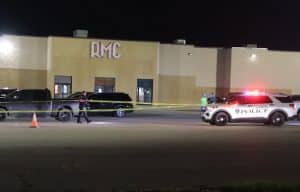Monroe County reports new COVID deaths as active cases top 1,000
Monroe County’s active case count for COVID-19 topped 1,000 this week, and two new deaths were reported.
Monroe County Health Department Administrator John Wagner reported a new death Wednesday, stating it was of a man in his 70s. On Thursday, Wagner received word of another death from earlier this week of a man in his 60s. This brings the county’s total COVID-related death toll to 111.
On Wednesday, Monroe County had 1,149 active coronavirus cases, with the total rising to 1,169 on Thursday. These figures came from the state’s National Electronic Disease Surveillance System, or I-NEDSS.
However, Wagner just learned the auto-close function on the I-NEDSS system may have a glitch. After an individual counted as an active case reaches the end of the 10-day isolation period – which consists of five days quarantining and five days masking when in public – the auto-close feature takes this person out of the active case count.
Wagner learned of this malfunction recently when a staff member from another health department asked about their county’s numbers.
It appears the only data affected would be the active case counts beginning Tuesday, at worst. Over the weekend, Wagner reported I-NEDSS data tracked a decrease in cases – Friday’s count was 974 and Monday’s was 948 – which is an indication cases were being removed after individuals finished their isolation period.
On Friday, Wagner said he believed I-NEDSS case count to be so inaccurate he did not want to report it. Yet, he said he believes the active case count to still be over 1,000.
“There’s nothing that indicates a reduction,” he said.
How many local residents are hospitalized, though, is perhaps even less clear.
“We have no idea,” Wagner said. “With all these cases, we can’t keep track of who is going to the hospitals.”
In the past, the hospitals would call the local health department when a Monroe County patient was admitted. Now, St. Louis-area hospitals are hitting all-time high records of COVID patients and are too busy to inform every local health department when a new patient comes in, Wagner said, estimating the local count is probably somewhere in the 20s.
On Friday, the St. Louis Metropolitan Pandemic Task Force reported 1,378 are currently hospitalized for COVID-19 at facilities within the BJC HealthCare, SSM Health, Mercy and St. Luke’s Hospital systems.
Of Wednesday’s patient count, 80-90 percent were hospitalized because of COVID symptoms. The rest tested positive for COVID while being treated for other conditions, officials from the task force said.
Among those hospitalized Friday, 28 are children ages 0-11 (six in ICU) and 18 are children ages 12-18 (three in ICU).
As Dr. Alex Garza, co-leader of the task force and chief community officer for SSM Health explained, the number of new admissions “continues to be unsustainably high.”
On Friday, 233 new patients were admitted to St. Louis area hospitals due to COVID. The ICU census for COVID-positive individuals was 214, with 129 of them on ventilators.
In neighboring St. Clair County, 136 are hospitalized due to COVID as of Wednesday and 55 of them are under 60 years of age. Seventy percent of those hospitalized in St. Clair County are unvaccinated. Of those hospitalized, 15 are in the ICU and five are on ventilators.
“We’re very fortunate, at least for now, that a smaller percentage of COVID patients are ending up in the ICU compared with Delta. However, it’s still a large number and it’s severely straining our capabilities to take care of people who are sick for other reasons,” Garza said.
Yet, this does not mean Omicron is a “weak” variant.
“We hear from many people that the Omicron variant is milder than Delta and other variants, and many people interpret this to mean Omicron is not as serious and not as dangerous, and that’s simply not true. There is some indication that Omicron may cause somewhat milder illness, especially in vaccinated individuals or otherwise healthy people, but how much so isn’t really clear and again, vaccinations may play a big role in that,” said Dr. Clay Dunagan, task force co-leader and BJC chief clinical officer.
He continued, “In just a few weeks, Omicron has resulted in many more infections than any of the previous variants and it’s caused a record number of people to be hospitalized in cities across the country. The overall toll it’s taking on our citizens is unprecedented in this pandemic.”
On Friday, the task force reported 17 new COVID deaths in the St. Louis area, which “is higher than at any point in which vaccines have been available,” Garza said.
On top of this, hospitals are struggling to maintain enough staffing to take care of the ever-increasing number of COVID patients.
According to task force data, the majority of individuals hospitalized with COVID-19 are unvaccinated.
Garza said those who are vaccinated and hospitalized often have severe underlying medical conditions or had not been recently vaccinated, meaning their immunity has since waned.
He explained this is why booster doses are so important – especially when considering the Omicron variant.
“It’s a very small percentage of patients who are in the hospital right now that have received their two-dose course plus their booster. We’re just not seeing those patients,” Garza said. “The bottom line is this: We know that vaccines make a really large, positive difference for people and prevent serious illness for the vast majority that receive the vaccines.”
Illinois Department of Public Health data shows 57.84 percent (19,860 residents) of Monroe County’s eligible population is fully vaccinated. This includes the newly-eligible 5-11 age group. There have been 9,155 booster doses administered to Monroe County residents.
The Monroe County Health Department is held a Pfizer vaccine clinic Thursday, Jan. 13, at Rock City in Valmeyer. Wagner said at the clinic, the health department administered approximately 80 doses.
On Saturday, 150 vaccines were administered during a clinic at Morrison-Talbott Library in Waterloo.
A pediatric vaccine clinic will be held at Rock City on Tuesday, Jan. 18, from 3-5:15 p.m. This clinic is for ages 5-11 only.
For all clinics, those getting a second or booster dose must bring their vaccination card.
St. Louis area hospitals are not the only ones topping COVID patient records. On Tuesday, the United States surpassed its Jan. 14, 2021 peak of more than 142,000 hospitalized by reaching 145,982 active hospitalizations.
Almost 24,000 ICU beds across the country are now taken by COVID-19 patients.
With the number of those hospitalized due to COVID rising, so is the demand for associated treatments. There is more demand for monoclonal antibody infusions than many hospitals can comfortably supply.
In a St. Louis Metropolitan Pandemic Task Force press briefing on Jan. 5, Dunagan said these treatments are also proving to not be as effective against the Omicron variant.
He said there is a newer agent that proves to help fight Omicron, yet, it is in short supply.
This intravenous treatment is limited to people who are COVID-positive and deemed at high risk for serious illness. Early intervention is key to the treatment, and it is done only in medical settings.
Last week, the IDPH announced Paxlovid (made by Pfizer) and Molnupiravir (made by Merck), two oral antivirals for COVID-19, will be available in Illinois later this month. They will be distributed by prescription only, and, like monoclonal antibody treatment, will be reserved for COVID-positive individuals with a high risk of becoming severely ill from the disease.
“These new oral antivirals add new tools to our toolbox to keep people with COVID-19 out of the hospital,” IDPH Director Dr. Ngozi Ezike said in a press release. “While vaccination, including boosters, is still the best way to avoid infection and prevent severe illness from COVID-19, these new antivirals given emergency use authorization by the Food and Drug Administration can help treat those who get infected and have a higher risk of becoming severely ill.”
The Biden administration said Friday that Americans can begin ordering free at-home COVID tests starting Jan. 19.
Orders for up to four tests per household can be placed online by clicking here. The White House said these tests will ship within 7-12 days of ordering.
School, events fallout
Last week, Waterloo High School students switched to remote instruction as a large number of employees were absent due to COVID or waiting on results of COVID tests.
WHS students learned remotely Thursday, Friday and Monday, with students returning to in-person instruction Tuesday.
WHS staff who were not absent during this time filled open positions at lower grade levels, allowing younger students to stay in-person.
Waterloo Superintendent of Schools Brian Charron told parents in an online announcement that as high schoolers come back, the district will continue to focus attention on “minimizing the disruption of the school day” for elementary grades.
For junior high and high school classes whose teacher is absent, they will spend the class period in larger spaces. During this time, students can complete work assigned by their absent teacher or otherwise use it as a study hall.
While Waterloo has been the only district to have students remote learn due to staffing absences, it has not been the only one concerned.
Wagner said Columbia and Valmeyer had also been talking with the health department on how – if it were to become necessary – to best handle school closures and remote learning. They, too, have been seeing a larger number of employees absent than normal.
With COVID cases on the uptick, a handful of local groups are deciding to either postpone gathering or do so virtually.
Waterloo Citizens for a Pool and Waterloo Listens both recently held January monthly meetings over Zoom, a virtual meeting platform, as they had done in the past before vaccines were widely available.
“We decided that with the high-spread rate in the county and surrounding areas and with several people having been at gatherings for the holiday that it would be best to switch to virtual, at least here for January, to prevent any further spread and to just keep all of our attendees and their families safe,” WCP President Amy Grandcolas said.
Last week, St. Paul United Church of Christ in Waterloo announced it will be pre-recording services and posting them to YouTube instead of welcoming its congregation in-person.
Pastor Jeff McCarn said the decision was made because local cases continued to climb and saw many of its own members become sick with COVID or other illnesses.
“We just felt it was kind of a no-brainer that we (should) change our worship and go to virtual since we had that capacity to keep people from being around one another as much as possible,” McCarn said, adding that “We have allowed AA to continue using the building and our Martha’s Kitchen Monday night meal will continue, because it’s carry-out only, and the blood drives still will happen.”
These groups’ move to virtual was also based on their own members’ comfort levels.
As McCarn explained, the church’s governing board spearheaded its decision.
When Waterloo Listens gave members the option to postpone its January meeting in hopes the surge would soon clear or meet on Zoom, it became clear the majority wanted to still meet, even if virtually. While WCP debated meeting in-person at Morrison-Talbott Library – as it had for much of 2021 – or online, they too sought member feedback.
“I asked our board members the week before if they had any concerns about being sick, recent travel, or exposures and if they would prefer Zoom to just reply to me and let me know,” Grandcolas said. “A couple (said) that due to recent travel or family gatherings there was a possibility that they were exposed and they were waiting to learn more from other people’s tests. So once two or three of those came back, I made the decision to move it to virtual as the cases had risen since that original question.”
When noticing they were not selling as many tickets for the Monroe County Farm Bureau Young Leaders’ annual Beef N’ Boogie – a Jan. 8 fundraiser for the Jonah K. Matthews Memorial Scholarship Fund in honor of the Young Leaders member – as in the past, farm bureau office manager Brenda Seboldt began asking ‘Why?’
She, too, found the virus was once again causing concern among Monroe Countians.
“We thought maybe it was just because of the holidays being so close, but as we started talking to more people they said, ‘It’s a good event, but I don’t want to be in a big crowd,’” Sebolt explained.
With Hecker Community Center understanding and helping to reschedule the event, the Young Leaders made a decision to postpone the Beef N’ Boogie to April 2.
“We didn’t want to have an event that would cause more groups of people to be sick and out of work and the fact that it was a fundraiser and we knew we wouldn’t be able to make any money at the event (influenced their decision),” Seboldt said.
WCP, Waterloo Listens and St. Paul UCC-Waterloo said they will continue to watch how the virus takes shape, including the county’s COVID positivity rates, to decide when they will actually return in-person. For now, the church is setting Jan. 30 as its target date to resume in-person services.
“We would like to make time and place appropriate decisions, and I think our members are flexible about that,” said Amanda Chase, one of the administrators of Waterloo Listens. “So, if it’s safe to meet in-person again, of course we would love to be together. We just feel like right now the responsible thing to do is carry out our mission in this way online.”
Chase said Waterloo Listens’ mission itself supports the change.
“I feel like we should be a leader in that aspect (of going virtual) because of our mission to advocate for justice for all – that includes hearing the concerns of the immunocompromised and that we give everybody that equal opportunity the opportunity to participate and contribute,” Chase said.
Chase said the Monroe County Bar Association, which she is an officer of, felt this same obligation to set a good example for the community, and so did St. Paul UCC in Waterloo.
“We also saw it as an opportunity to be leaders in the community, just to say that even if we were the only church doing this, we believed it was the right thing to do for the safety, health and well-being of not only just our church members, but our entire community,” McCarn said.
While Chase and Grandcolas said they will both miss the camaraderie meeting in-person can foster in their organizations, they are both confident they made the right decision.
“We would love to be together to encourage each other, to give each other hugs, but really we feel like the mission can still be accomplished online via Zoom and we can still encourage each other without taking that unnecessary risk,” Chase said.
Grandcolas said she has found there are advantages to meeting online, such as allowing those with busy lifestyles to still be involved.
“We’ve had parents join our meetings while they’re sitting in the car while their kids are inside at a practice,” Grandcolas said. “So, (Zoom) gives them more flexibility to be more active and participatory in the community organizations, because they can join from anywhere and they don’t have to get themselves to a physical location to participate.”
For other organizations debating on following the step of these organizations or postponing their events, Wagner said it might be the best option.
“If you have any type of meeting where you may have any type of vulnerable population at all, right now it would be better to either do it remotely or postpone it,” Wagner said.






